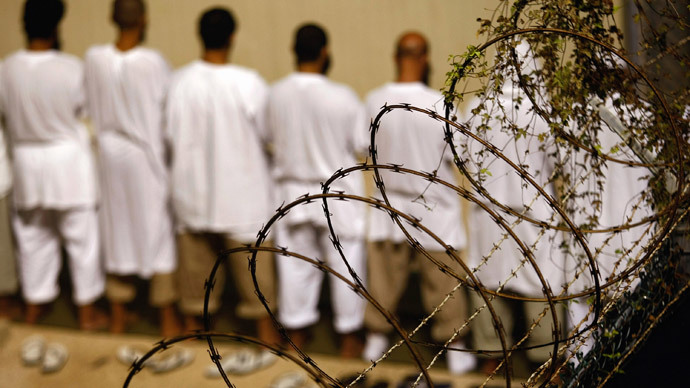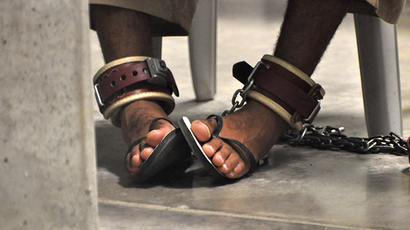US govt ordered to release Gitmo force-feeding videos

For the first time since its opening 12 years ago, a federal court has intervened in proceedings at the Guantanamo detention facility, ordering the US to supply videos showing the force-feeding of a Syrian hunger-striker.
On Wednesday, a federal judge ruled that lawyers for Abu Wa’el
Dhiab, 42, can view hours of his videotaped force feedings. The
decision marks the first time a non-government official has been
granted permission to view the secret recordings from Gitmo, a
detention facility cloaked in secrecy since its opening in 2002.
Last week, US District Judge Gladys Kessler ordered the Obama
administration to temporarily stop force-feeding Dhiab, while
also demanding that it release his medical records and 34 of 136
videotapes of force-feeding sessions taken between April 9, 2013,
and February 19, 2014.
A detainee at the US military prison for more than a decade
without any formal charges or trial, Dhiab "resumed hunger
striking because of the delay in releasing him," his lawyer
said in a court petition filed Monday.
According to Reprieve, a London-based human rights group that
represents several detainees, Dhiab has succumbed to “bodily
pain” by so-called “Forcible Cell Extraction” teams, which
are employed at Gitmo for the purpose of forcibly restraining a
hunger-striking detainee and moving him to the force-feeding
chair.
"Dhiab remembers having his ribs hurt by the FCE team and
having severe pain in his lower back/thigh, neck and head as a
result of the forcible cell extractions," it added.
In last week’s court filing, the detainee compared with
“torture” the forced feeding sessions - in which inmates
are strapped to a chair and fed enterally by the insertion of a
plastic tube through the nose and into the stomach.
“Sometimes the way the MP [military policeman] holds the head
chokes me, and with all the nerves in the nose the tube passing
the nose is like torture,” Dhiab said. “Then, especially
when the MP is holding the neck, when they try to force the tube
through the throat it often catches and they cannot push it
through. At times like these, I ask them to videotape. And they
refuse.”
Although the videos will not be made available to the public, it will give non-government officials a first-hand look at the practice of force-feeding, which rapper Yasiin Bey, otherwise known as Mos Def, provided some insight as to how painful the procedure can be when he volunteered to sit for a feeding in a publicly released video.
Although their clients are condemned to a detention that can only
be described as hellish, Reprieve described the court decision as
a victory for the detainees.
"It's 12 years late, but it's fantastic, it's the first time
a federal court has started paying attention to the conditions of
confinement in Guantanamo, that's a huge step," Reprieve's
Founder and Director Clive Stafford Smith.
More than 12 years after Guantanamo first opened its doors in
January 2002, the US detention center in Cuba still holds 154 men
out of an estimated 800 individuals – many of them innocent of
any crime – who passed through Gitmo’s gates in the course of the
war on terror.
The hunger strike began in February of last year as a protest by
the prisoners against their indefinite detention at Guantanamo
Bay, built to hold captives in the Global War on Terror, which
the US initiated after the 9/11 attacks.
More than two-thirds of Guantanamo’s inmates refused food when
the strike reached its peak. In order to deal with the situation,
the United States opted to force-feeding techniques, and despite
the process being labeled as “torture” by the UN Human
Rights Commission.
Meanwhile, letters by several detainees delivered to the Guardian
by Reprieve accuse officials at Guantanamo of manipulating the
actual number of detainees participating in hunger strikes.
“There is a scheme here to avoid blame about the
force-feeding,” wrote Hassan, a Yemeni who remains confined
at Gitmo despite the US government approving his transfer in
2010.
“When the doctor stops feeding four detainees, he decreases
the total number of hunger strikers to 13. When their weight goes
down and the doctors have to feed him, he cancels three or four
others so he can keep the numbers of hunger strikers low. I am
hesitating between refusing the feeding until the doctors decide
to force-feed me, and waiting to see what will happen in the next
two-three weeks.”
US military officials at Guantánamo refuted the allegations,
saying they only resort to force-feeding if the health of a
prisoner is at risk.
“Medical personnel monitor detainees' health on a regular
basis to ensure the detainees' safety,” Commander John
Filostrat told the British paper.
In any event, legal experts hope the released medical records and
videotapes will shed some light on one of the darkest pages of
American history in which the United States arguably behaved
worse than the “worst of the worst” inmates it had
imprisoned at Guantanamo, a facility that Amnesty International
once dubbed “the Gulag of our times.”














